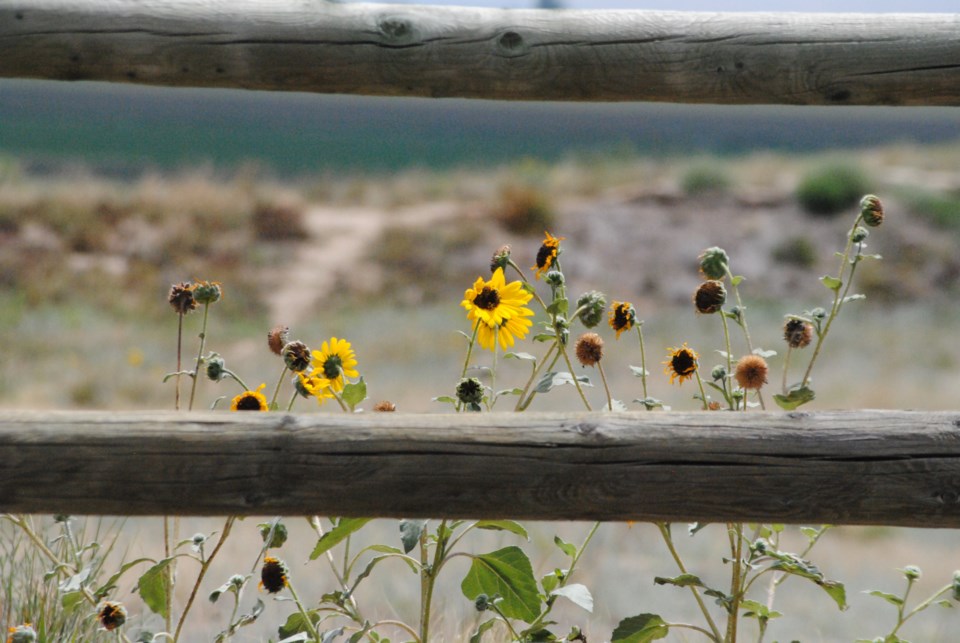This content was originally published by the Longmont Observer and is licensed under a Creative Commons license.
Their bright yellow faces bring up visions of summer, sunshine, and blue skies. Sunflowers are everywhere, whether planted intentionally or unintentionally. They line roadways and fill fields. The domestic sunflowers you plant have very close wild cousins in Colorado. You love to look at them, but how much do you really know about them?
Sunflowers are a member of the aster family and are one of about 70 members of the genus Helianthus. One of the scientific names for the aster family is Compositae, which is a fitting description. The first thing that may come as a surprise to you is that what you view as a single flower is actually hundreds of tiny flowers! Sunflowers are made up of ray and disc flowers. The bright yellow part which, you might refer to as the petals of the sunflower, is actually the ray flowers. These can range in color from yellow to orange depending on the species. The middle part of the flower, which is often brown in color, is actually many disc flowers spaced closely together. Each “flower” that you see is actually 300-1000 tiny flowers. Disc flowers occur in whorls or spirals, with the outermost flowers opening first. The ray flowers spread about the same time as the first disc flowers open. Disc flowers continue to open several rows at a time for about five days until the middle of the composite head is reached. If the plant has been pollinated, seeds will develop from the disc flowers.
As an interesting aside, the spirals of disc flowers occur in what is known as a Fibonacci spiral. Fibonacci was a mathematician who came up with what is called the Fibonacci sequence. Bear with me, there is some simple math here. Each number of the sequence is found by adding up the two numbers that came before it. For example, you start the sequence with 0 and 1, so the next number is 0 + 1 or 1. Now the sequence is 0, 1, 1. The next number is 1 + 1 or 2 so you have a sequence of 0, 1, 1, 2. The next number in the sequence will be 3, and the one after that will be five. Why is this important? Because if you were to count the spirals of disc flowers, you will always come up with a number that is in the Fibonacci sequence. Nature is full of examples like these.
The stems and leaves of the sunflower are covered with tiny hairs. The leaves are often described as being heart-shaped and are light to dark green. Leaves are usually directly opposite each other on the stem, but in some species the leaves may alternate on the stem.
Sunflowers were not always produced for consumption by people and songbirds. Commercially, sunflowers were originally produced as silage and food for poultry. The sunflower’s reintroduction in Russia is what led people to start cultivating it as an oilseed. Sunflower oil is considered a healthy oil for cooking and has a high smoke point; which means it can be used with high heat. The meal left over from the oil extraction process makes good animal feed and contains 50-60% protein. The sunflowers that are produced for human consumption tend to be non-oil varieties as the seeds are larger and they are higher in protein. The flowers themselves can be used as a yellow dye.
Domestic sunflowers are able to hybridize with wild sunflowers, and many times they grow close to each other. Many of the sunflowers you see along roadsides are likely hybrids with domestic sunflowers. Flowers are primarily pollinated by bees rather than the pollen being spread by the wind. The sunflower pollen is heavy and therefore, does not spread easily when blown. The pollen has adapted to be carried by insects and is spiny so that it sticks to the legs of the insects more easily. Bees may pollinate flowers on the same composite head or pollinate neighboring flowers during feeding.
Sunflowers occur both as annuals and as perennials. One perennial some of you may be familiar with is the Jerusalem artichoke or sunchoke which is native to Canada, but is sold to be grown in gardens in the US because the tuber is edible.
Sunflowers orient themselves toward the sun throughout the day. Because of this, they are known as heliotropes or sun lovers. During the day, the flowers track the sun from east to west. At night, the process is reversed so that the flowers will be facing east again when the sun rises in the morning. At some point, when the plant matures, this process stops and the flowers mostly face east. The process by which sunflowers are able to orient the flowers toward the sun was only recently discovered. Plants have their own circadian rhythm, which, in addition to hormones, allows the composite flower head to track the sun. Sunflowers are thought to do this because it allows the plants to grow faster. In fact, when the composite flower head is facing east, the east side of the stem grows faster than the west side. The reverse is true when the composite flower head is facing west. When mature flowers stop tracking the sun and face east, scientists have discovered that the flowers heat up faster and attract up to five times more pollinating insects than flowers that don’t face east. Other experiments showed that insects prefer warm flowers.
Incidentally, sunflowers derive their scientific name, Helianthus, from an ancient Roman myth. The nymph Clytie was in love with the sun god, Helios. After Helios jilted her, Clyltie spent nine days on a rock outcropping staring at the sun. At the end of the nine days, she turned into a plant with a flower that followed the sun. As you can see, there is so much more to appreciate about sunflowers beyond their beauty.



